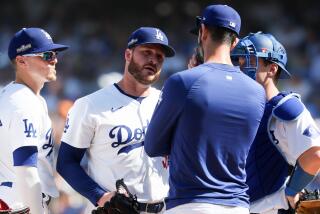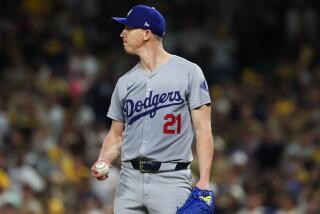Cubs were in proper alignment for defense and Game 1 win over Dodgers

Reporting from Chicago — Of the many thousands of baseballs hit into play this season against the Chicago Cubs, the team converted more of them into outs, relative to their competition, than any other team in this sport’s history.
Rather than the major league standard of a .300 average on balls put into play, Cubs opponents averaged only .265. The next-best defensive team, Toronto, would have recorded more than 100 fewer outs. The worst defensive teams would have lost multiple outs per game. And the Cubs did this while logging the lowest number of shifts across Major League Baseball.
When asked in a pre-series news conference Friday how his club had managed to play league-best defense while shifting less than anyone else, Cubs Manager Joe Maddon pushed back. His club was shifting all season long, he indicated, just not into alignments traditionally defined as defensive shifts.
“It’s only counted when the shortstop moves on the other side of the second baseman or the second baseman moves on the other side,” Maddon said. “I think we’re still in an appropriate defensive alignment. We still move a lot. We just maybe don’t move to the other side of the bag where it gets notated.”
The trend continued into Saturday’s Game 1 of the National League Championship series at Wrigley Field, when the Dodgers repeatedly pounded the ball across the field and the Cubs consistently caught them. Most of the time, the drives went right to defenders. Those appear unlucky, and they often are, but they are also a product of plus positioning.
The unusual thing was that Andre Ethier’s fifth-inning pinch-hit home run, the Dodgers’ first run of the game, was not struck as most home runs are. They hit five balls harder earlier in the game, and four were outs.
The first borderline ball put into play by the Dodgers that went for a hit was Andrew Toles’ pinch-hit shot through the hole at shortstop. Hitting for the pitcher to begin the eighth, Toles tapped the grounder, and Addison Russell could not glove it. Two batters later, there was another borderline ball that went the Dodgers’ way, Justin Turner’s tapper to third, when Toles beat Kris Bryant to the bag. Two batters after that, there was another, when first baseman Anthony Rizzo dropped Yasiel Puig’s foul pop. Left-handed pull hitter Adrian Gonzalez followed with a tying single up the middle through the Cubs’ shift.
Discussing the shift, Maddon added that, anecdotally, there are far more true-pull left-handed hitters in the American League. With Tampa Bay almost a decade ago, Maddon essentially popularized the defensive shift, but that was, he said, in part because of his league.
“Playing in the National League this year, I don’t see that as being as excessive,” he said. “I might be wrong, but, just observationally, I think that’s true. I also believe that the range of our kids, our guys out there, athleticism on defense and the pitchers, they have to work in concert where the pitcher elicits weaker contact which makes your defense becomes bigger.
“If your pitching staff doesn’t elicit weak contact, your defense becomes smaller. I think that all is a part of the equation.”
Cubs starter Jon Lester did not elicit weak contact in Game 1. The Dodgers did not benefit from the so-called smaller defense, at least until the eighth inning. The statistics say they could continue to lose liners into gloves during Game 2 and beyond. If so, the Cubs’ defense may go down as one of the chief causes of a Dodgers loss, even with Clayton Kershaw set to start Sunday.
“We have good defenders, our coaching staff puts us in good spots, and we go and get it,” Cubs left fielder Ben Zobrist said. “When you do that, you give your pitcher extra pitches and you allow him to trust his defense more. This team has done it all year defensively. Our pitching staff has done it.
“And that’s really the formula, because we’re gonna face some good pitching tomorrow.”
Twitter: @pedromoura
More to Read
Are you a true-blue fan?
Get our Dodgers Dugout newsletter for insights, news and much more.
You may occasionally receive promotional content from the Los Angeles Times.










